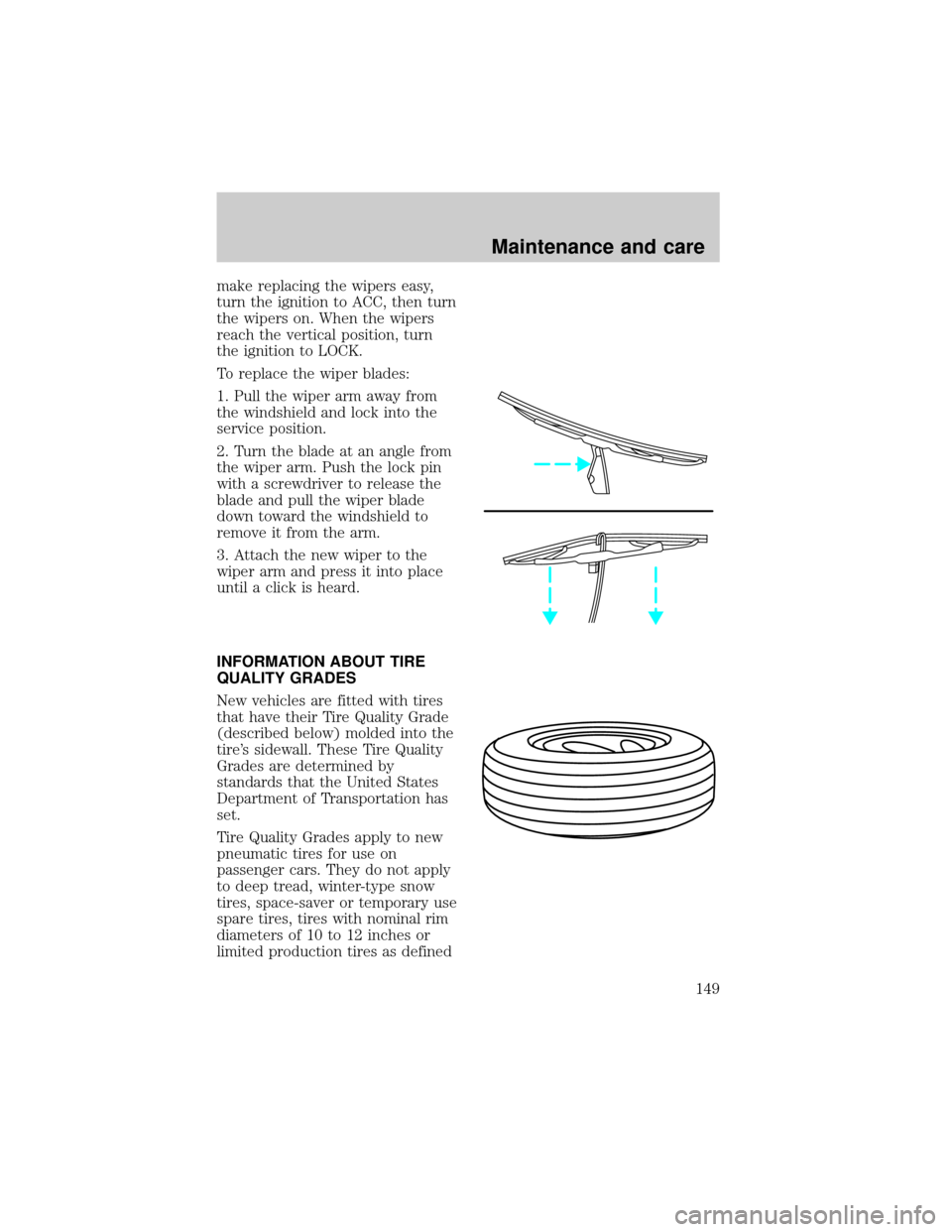Page 115 of 191
²use the wheel for any other type
of vehicle
Tire change procedure
1. Park on a level surface, activate
hazard flashers and set the parking
brake.
When one of the front
wheels is off the ground,
the transaxle alone will not
prevent the vehicle from moving
or slipping off the jack, even if
the vehicle is in P (Park)
(automatic transaxle) or R
(Reverse) (manual transaxle).
To prevent the vehicle
from moving when you
change a tire, be sure the
parking brake is set, then block
(in both directions) the wheel
that is diagonally opposite (other
side and end of the vehicle) to
the tire being changed.
If the vehicle slips off the
jack, you or someone else
could be seriously injured.
2. Place gearshift lever in P (Park)
(automatic transaxle) or R
(Reverse) (manual transaxle) and
Roadside emergencies
115
Page 149 of 191

make replacing the wipers easy,
turn the ignition to ACC, then turn
the wipers on. When the wipers
reach the vertical position, turn
the ignition to LOCK.
To replace the wiper blades:
1. Pull the wiper arm away from
the windshield and lock into the
service position.
2. Turn the blade at an angle from
the wiper arm. Push the lock pin
with a screwdriver to release the
blade and pull the wiper blade
down toward the windshield to
remove it from the arm.
3. Attach the new wiper to the
wiper arm and press it into place
until a click is heard.
INFORMATION ABOUT TIRE
QUALITY GRADES
New vehicles are fitted with tires
that have their Tire Quality Grade
(described below) molded into the
tire's sidewall. These Tire Quality
Grades are determined by
standards that the United States
Department of Transportation has
set.
Tire Quality Grades apply to new
pneumatic tires for use on
passenger cars. They do not apply
to deep tread, winter-type snow
tires, space-saver or temporary use
spare tires, tires with nominal rim
diameters of 10 to 12 inches or
limited production tires as defined
Maintenance and care
149
Page 186 of 191

IDENTIFYING YOUR VEHICLE
Safety compliance label
The National Highway Traffic
Safety Administration Regulations
require that a Safety Compliance
Certification Label be affixed to a
vehicle and prescribe where the
Safety Compliance Certification
Label may be located. The Safety
Compliance Certification Label is
located on the front door latch
pillar on the driver's side.
Vehicle identification number
The vehicle identification number
is attached to a metal tag and is
located on the driver side
instrument panel.
Engine number
The engine number (the last eight
numbers of the vehicle
identification number) is stamped
on the engine block, transmission,
frame and transfer case (if so
equipped).
MFD. BY FORD MOTOR CO. IN U.S.A.
EXT PNT: XXXXXX XXXXXX RC: XX DSO: XXXX F0000
BAR INT TR TP/PS R AXLE TR SPR T0000
X XX XXX X XX X XXXX
UTC
ÑFOHT-15294A10-GA
MAXIMUM LOAD=OCCUPANTS + LUGGAGE=XXXKG/XXXXLB
OCCUPANTS: X TOTAL X FR X 2ND X RR OCCUPANTS LUGGAGE
XX XXXKG/XXXXLB
TIRE: XXXX/XXXXX XXX X XXXKG/XXXXLB
PRESSURE (FR) XXX kPa/33 PSI COLD
PRESSURE (RR) XXX kPa/33 PSI COLD
TRAILER TOWING - SEE OWNER GUIDE
DATE: XXXXX GVWR:XXXXX LB/ XXXXX KG
VIN: XXXXXXXXXXXXXXXXX TYPE: XXXXXXXXXXXXXXX FGAWR: XXXXXX/XXXXXXX RGAWR: XXXXXXX/XXXXXXX
THIS VEHICLE CONFORMS TO ALL APPLICABLE FEDERAL
MOTOR VEHICLE SAFETY STANDARDS IN EFFECT ON THE
DATE OF MANUFACTURE SHOWN ABOVE.
XXXXXXXXXXXXXXXXX
AIR BAG
Capacities and specifications
186